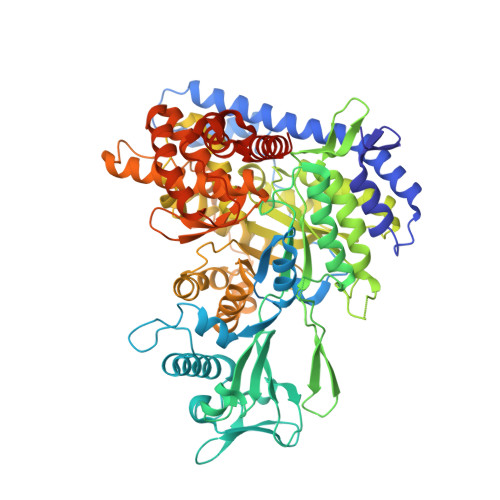Anion-pi Interactions in Computer-Aided Drug Design: Modeling the Inhibition of Malate Synthase by Phenyl-Diketo Acids.
Ellenbarger, J.F., Krieger, I.V., Huang, H.L., Gomez-Coca, S., Ioerger, T.R., Sacchettini, J.C., Wheeler, S.E., Dunbar, K.R.(2018) J Chem Inf Model 58: 2085-2091
- PubMed: 30137983
- DOI: https://doi.org/10.1021/acs.jcim.8b00417
- Primary Citation of Related Structures:
6APZ, 6AS6, 6ASU, 6AU9, 6AXB, 6BA7, 6BU1, 6C2X, 6C6O, 6C7B, 6C8P, 6DKO, 6DL9, 6DLJ, 6DNP - PubMed Abstract:
Human infection by Mycobacterium tuberculosis (Mtb) continues to be a global epidemic. Computer-aided drug design (CADD) methods are used to accelerate traditional drug discovery efforts. One noncovalent interaction that is being increasingly identified in biological systems but is neglected in CADD is the anion-π interaction. The study reported herein supports the conclusion that anion-π interactions play a central role in directing the binding of phenyl-diketo acid (PDKA) inhibitors to malate synthase (GlcB), an enzyme required for Mycobacterium tuberculosis virulence. Using density functional theory methods (M06-2X/6-31+G(d)), a GlcB active site template was developed for a predictive model through a comparative analysis of PDKA-bound GlcB crystal structures. The active site model includes the PDKA molecule and the protein determinants of the electrostatic, hydrogen-bonding, and anion-π interactions involved in binding. The predictive model accurately determines the Asp 633-PDKA structural position upon binding and precisely predicts the relative binding enthalpies of a series of 2-ortho halide-PDKAs to GlcB. A screening model was also developed to efficiently assess the propensity of each PDKA analog to participate in an anion-π interaction; this method is in good agreement with both the predictive model and the experimental binding enthalpies for the 2-ortho halide-PDKAs. With the screening and predictive models in hand, we have developed an efficient method for computationally screening and evaluating the binding enthalpy of variously substituted PDKA molecules. This study serves to illustrate the contribution of this overlooked interaction to binding affinity and demonstrates the importance of integrating anion-π interactions into structure-based CADD.
Organizational Affiliation:
Department of Chemistry , Texas A&M University , P.O. Box 30012, College Station , Texas 77842 , United States.

















